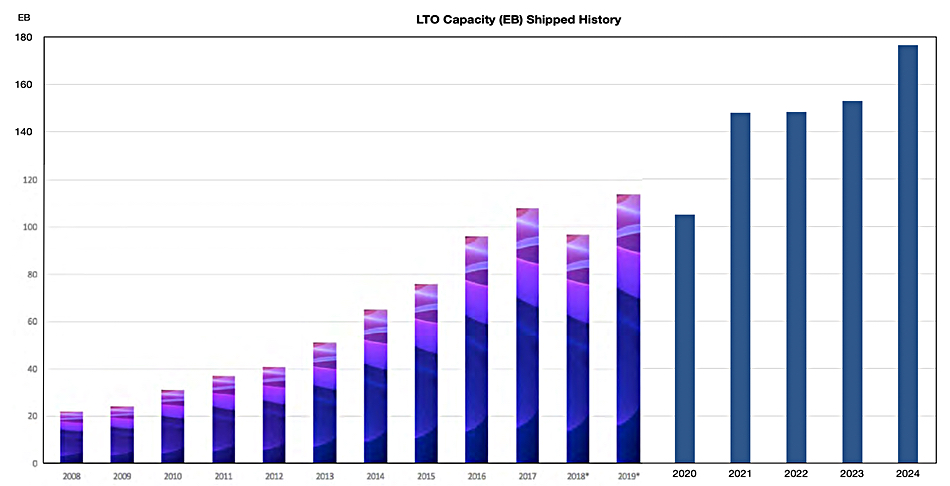There was 15.4 percent more LTO tape capacity shipped in 2024 compared to 2023 as growth resumed following three years of more or less level pegging after a pandemic dip.
The LTO Program Technology Provider Companies (TPCs) – HPE, IBM, and Quantum – released their annual tape media shipment report, saying a record 176.5 exabytes (EB) of total compressed tape capacity shipped in 2024, assuming a 2.5:1 compression ratio. Similar numbers are available for 2019 to 2023, but not for earlier years. However, the LTO org has previously produced a bar chart showing the 2008 to 2019 history. We have combined the old and new charts to provide a full 2008 to 2024 tape capacity shipped history:

There was a dip in 2018 due to a patent dispute between the two tape ribbon manufacturers, Fujifilm and Sony, which restricted the global supply of LTO-8 tape media until a cross-licensing deal was agreed between the two.
Capacity shipped then grew in 2019 to 114 EB, but was hit hard by the COVID-19 pandemic in 2020 with a fall to 105 EB. There was a ramp back up in 2021 to 148 EB, but dismal 0.5 percent growth in 2022 to 148.3 EB, and a laggardly 3.14 percent rise to 152.9 EB in 2023. Happily, the need to archive unstructured data has now resumed growing and we have a healthier 15.4 percent growth from 2023 to 2024.

Looking ahead to the hoped-for AI archiving demand, Bruno Hald, General Manager, Secondary Storage, at Quantum, said: “Setting a new growth record for the fourth year in a row, LTO tape technology continues to prove its longevity as a leading enterprise storage solution. Organizations navigating their way through the AI/ML era need to reconfigure their storage architectures to keep up, and LTO tape technology is an essential piece of the puzzle for those seeking a cost-friendly, sustainable, and secure solution to support modern technology implementation and the resulting data growth. We look forward to introducing the next iteration of LTO tape technology this year to bring enhanced storage capabilities to the enterprise.” Hald is referring to the LTO-10 format.
The LTO org says in its announcement that tape complements SSD and disk as an archival storage medium “to provide a low-cost, last line of defense against ransomware and other security threats.” And it mentions air-gapping, of course: “Further, offline copies of LTO tapes separate data archives from the connected environment, providing greater assurances for data recovery.”
It does not mention that LTO-10, unlike previous generational LTO changes, does not provide a speed increase over LTO-9, only saying: “LTO-10 … will provide the same blazing speed as LTO-9.” Nor does it mention LTO-10’s loss of backwards-compatibility or initial 30 TB raw capacity rather than the expected 36 TB raw capacity. Setting these relatively minor points aside, the future for LTO tape shipments looks good for the rest of 2025 and 2026. But if Microsoft’s Project Silica or Cerabyte or HoloMem get their various glass tablet technologies productized by 2027, 2028, or 2029, then we might see some real competition for tape developing.








